2001 Economic Update for the Capital District
Executive Summary
After the 1990-91 recession, the Capital Region economy experienced a recovery in 1992 and 1993 and a strong growth phase in 1994, with all-time high employment and low unemployment. But in 1995, Regional employment was down, unemployment up, and the Region entered into a local recession which persisted through 1996. In 1997, the Regional economy entered a modest recovery phase which strengthened in 1998, and in 1999 the transition was made to a growth phase, which has continued through 2001.
Price Indices
- The Consumer Price Index rose 2.2% in 1999 and 3.4% in 2000, while the Producer Price Index rose 0.8% in 1999 and 5.8% in 2000. For the most recent 12 months ending 10/01, the CPI rose 3.1% and the PPI was up 2.9%, indicating a decline in inflation. The Federal Reserve has reduced short- term interest rates below 2% for the first time in 40 years, so inflation and interest rates may be expected to experience further declines.
Employment & Unemployment by Place of Residence
- Average annual Capital District Regional employment for residents of the four counties rose by 3,483 or 0.9% in 2000, achieving a new all-time high of 403,500.
- Average annual Regional unemployment rose by 142 or 1.1% for 2000, while the unemployment rate remained unchanged at 3.3%.
- Data for the most recent 12 month period ending in October 2001 indicate that average Regional employment declined by 2,667 or 0.7%, unemployment declined by 1,800 or 13.2%, and the unemployment rate dropped to 2.9%, the lowest rate in over 25 years.
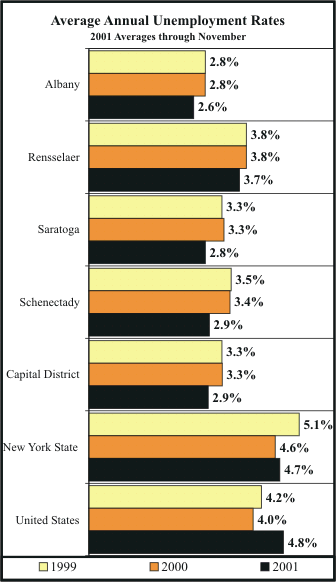
Albany-Schenectady-Troy Metropolitan Statistical Area
Sector Employment by Place of Work
{Note: the MSA includes Albany, Montgomery, Rensselaer, Saratoga, Schenectady, & Schoharie counties}
- Total public and private sector employment in the Albany-Schenectady-Troy MSA rose by 6,600 jobs or 1.5% in 2000 to a new all-time high of 457,000. For the first 10 months of 2001, average MSA employment rose another 4,400 to a new high of 461,400.
- State Government employment for the MSA declined by 400 or 0.7% for 2000, but has gained all of those jobs back during the first 10 months of 2001.
- Transportation & Public Utilities, another high-paying sector, posted a 900 or 5.0% job gain for 2000 and another 200, 1.1% increase for the first 10 months of 2001.
- The high-paying Manufacturing sector posted a 0.8%, 300-job decline in 2000 employment, and a 700-job, 1.8% job loss for the first 10 months of 2001.
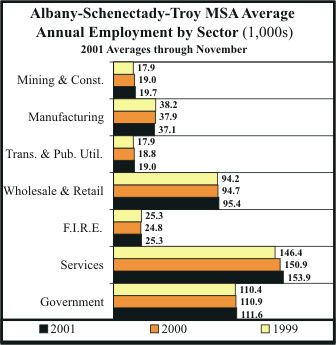
Regional Payroll and Average Annual Pay
- Average annual constant-dollar pay for the Region rose by $129 or 0.4% for 1999.
- In 1999, total Capital District constant-dollar payrolls rose by $333.7 million or 2.5% to a new Regional high of $13.4 billion.
- The gap between the highest and lowest paying sectors increased, as average annual pay in the Wholesale & Retail Trade sector declined from 46.7% of Manufacturing pay in 1998 to 45.7% in 1999.
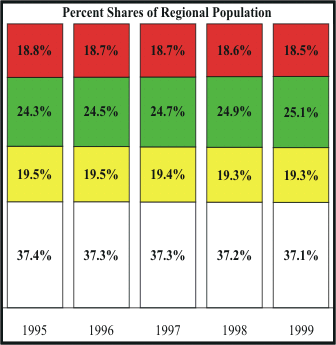
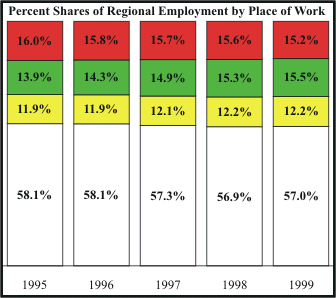
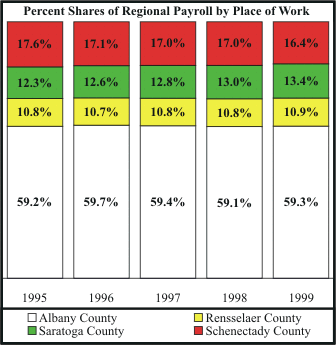
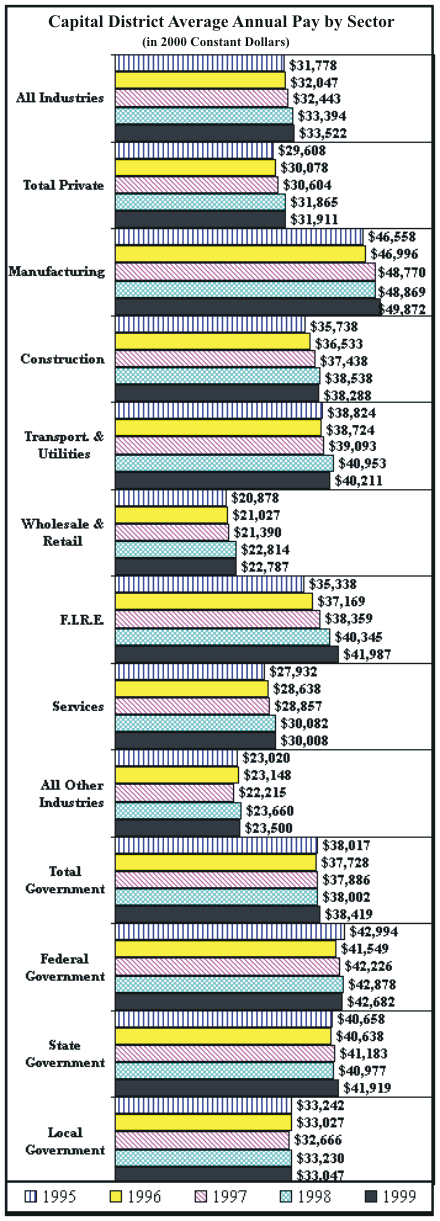
Regional Taxable Sales
- For the period September 1998 through August 1999, Regional constant-dollar taxable sales rose by $295.1 million or 3.4% from the previous 12-month period to $8.9 billion.
- The Regional increase in constant-dollar taxable sales exceeded the State’s increase (2.5%) for the first time in five years.
- Retail taxable sales rose $188.1 million or 3.7% for the latest reported 12-month period.
- Manufacturing taxable sales rose $83.8 million or 17.5% for the latest 12-month period.
- Construction taxable sales rose $9.0 million or 6.3% for the latest 12-month period.
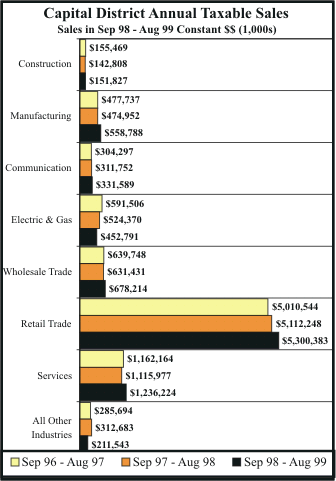
Transportation Hub Activity
- Enplanements at the Albany International Airport rose 302,731 or 25.7% to a new all-time high of 1,440,437 in 2000, following a 38,275, 3.4% increase in 1999.
- Total tonnage handled by the Port of Albany fell by 339,905 tons or 46.1%.
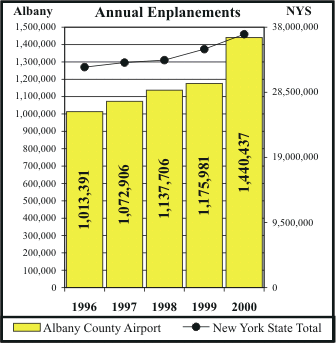
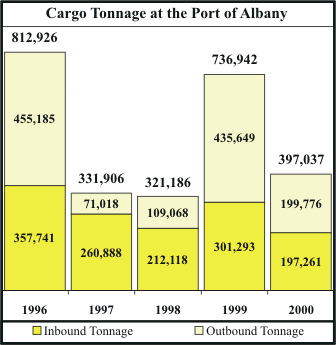
Commercial Office Space
- As of the Fall of 2001, total commercial office space in the Capital District was up 6.5% to approximately 17,289,100 square feet, while total occupied space increased 2.6% to about 15,694,504 square feet.
- Net absorption (the net change in occupied space) was approximately 398,276 square feet in 2001, representing gains for both the Albany CBD (+24,478 sq. ft.) and suburban areas (+373,798 sq. ft.).
- Commercial office vacancy rates rose in 2001, from 5.8% to 9.2%.
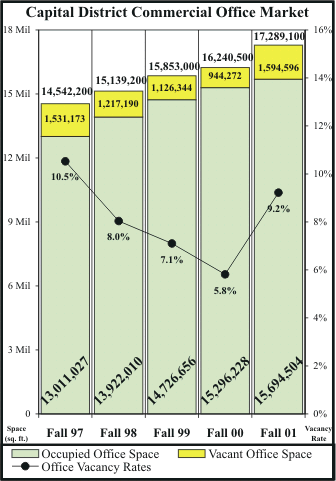
Building Permit Activity
- Total residential building permits rose by 93 or 4.1% in 2000, while the number of units for which permits were issued declined by 247 or 8.9%.
- The total constant-dollar value of residential permits fell by $19.4 million or 5.6%.
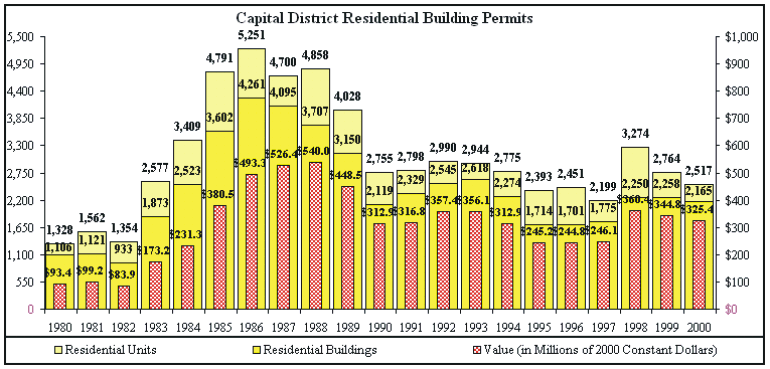
Existing Home Sales
- Unit sales of existing homes in the Capital District were down 39 or 0.5% for 2000, following a 735-unit, 11.2% increase for 1999.
- Average days to sale for existing homes declined by 13.5 days or 12.7% in 2000.
- The mean (arithmetic average) constant-dollar selling price for existing homes fell by $348 or 0.3% for 2000.
- The median constant-dollar selling price for existing homes rose by $1,721 or 1.5%.
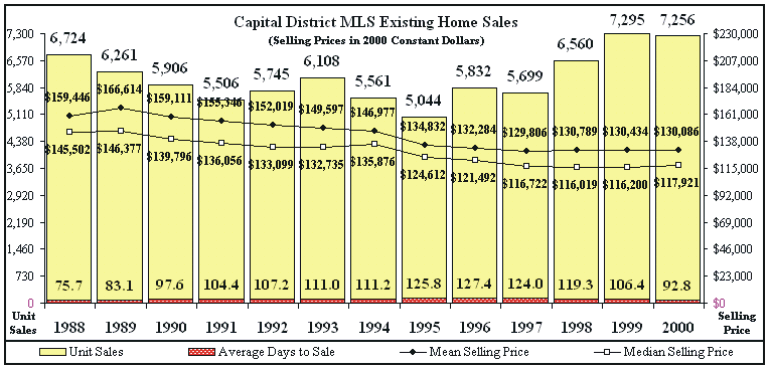
According to the National Bureau of Economic Research, the nation entered a recession in March of 2001. In contrast, the Capital Region has not yet shown any signs of joining the recession. While employment of Regional residents has declined for each month in 2001 by an average of 0.8% (compared to the same month in 2000: e.g., Jan. 2001 vs. Jan. 2000), the number unemployed declined even more, by an average of 14.4%, yielding much lower unemployment rates for each and every month in 2001. Most importantly, the equivalent data on jobs (for the Albany-Schenectady-Troy MSA — comparable county-level data are not available) show an increase in the number of jobs available in the area for each and every month of 2001 (again, based on same-month, prior year comparisons), with an average increase of approximately 6,200 jobs. The only major employment sector posting a decline in jobs was Manufacturing, where the 700-job decrease in 2001 employment through October is certainly no surprise, given the relocation of GE Power Systems headquarters and marketing staff to Atlanta, Georgia and the failure of Garden Way Corp. This also helps explain the decrease in employed residents in the Region.
The expected increases in State and federal services in response to the terrorist attacks of September 11th would suggest that future State and federal employment in and around the State Capital will remain stable or post actual increases. GE Power Systems currently has a very healthy order backlog which should help stabilize the manufacturing sector, and local retailers are reporting strong sales for the Christmas shopping season to date.
While the Capital Region is certainly not recession-proof, it appears positioned to experience, at worst, a mild, short, and delayed version of the current national recession. In fact, it is possible that the Region will avoid a recession entirely, and simply experience a slowing of economic activity instead of a decline.
Additional economic data and analysis may be found in CDRPC's publications. For more information, see CDRPC Publications.













 Return to CDRPC Home Page
Return to CDRPC Home Page